...
Login to DNS using domain admin credentials and create an alias for SBC:
| Panel |
|---|
|
| Caption |
|---|
| 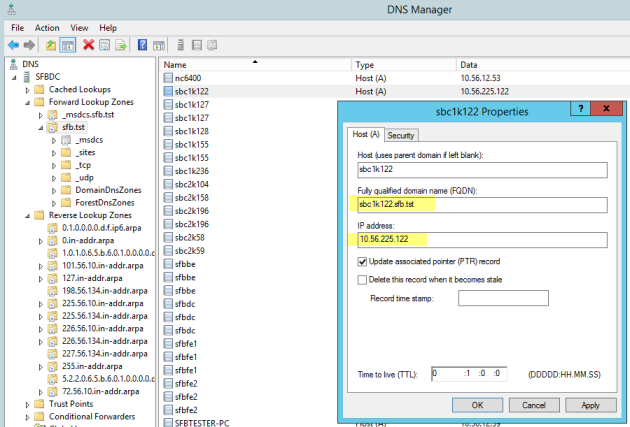 Image Modified Image Modified
|
|
Configure the SfB Management Shell
| Anchor |
|---|
| Configuring the SFB Manager |
|---|
| Configuring the SFB Manager |
|---|
|
...
Type the following command to enable CS Topology so that above configuration items can take effect in SfB topology:
Enable-CsTopology
| Panel |
|---|
|
| Caption |
|---|
| 0 | Figure |
|---|
| 1 | Commands and Output |
|---|
| 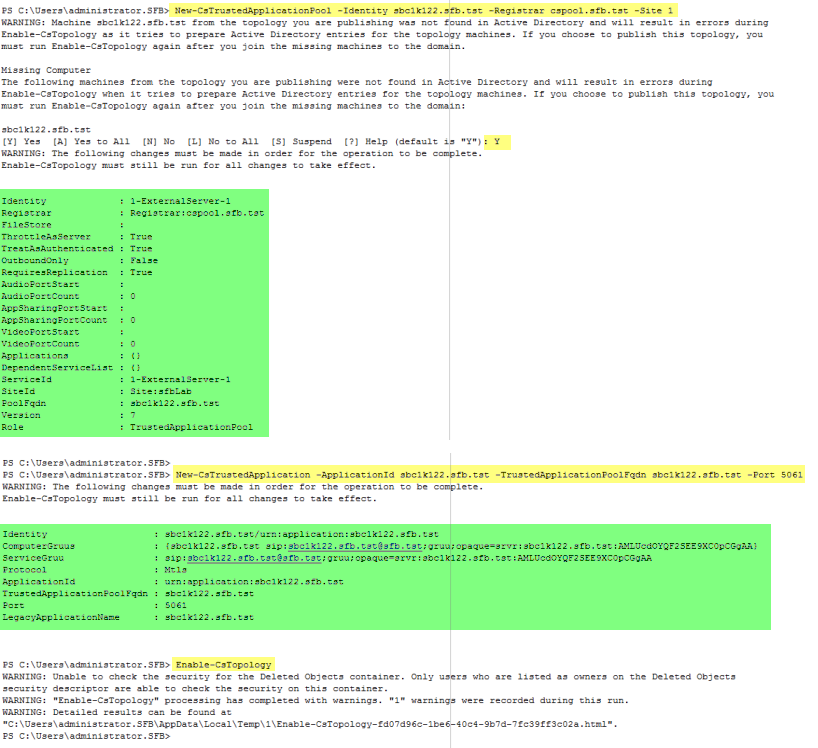 Image Modified Image Modified
|
|
Configure the Active Directory and the SfB Control Panel
| Anchor |
|---|
| Configuring the AD and the SFB Control Panel |
|---|
| Configuring the AD and the SFB Control Panel |
|---|
|
- Login to the Active Directory domain controller machine with domain admin credentials.
- Create AD users.
- Login to the Skype for Business front-end server.
- Launch the SfB Control Panel.
- Enable AD users to be enterprise-enabled SfB users on SfB Control Panel:
| Panel |
|---|
|
| Caption |
|---|
| 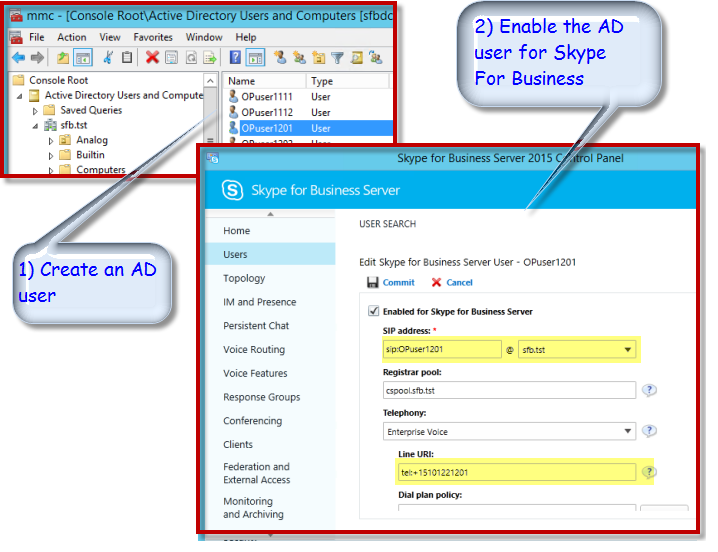 Image Modified Image Modified
|
|
Configure the SBC
| Anchor |
|---|
| Configuring the SBC |
|---|
| Configuring the SBC |
|---|
|
...
- Login to the SBC WebUI and navigate to Node Level Settings.
- Configure the SBC host name, domain suffix, and the DNS IP address:
| Panel |
|---|
|
| Caption |
|---|
| 0 | Figure |
|---|
| 1 | Configure Node-level Settings |
|---|
| 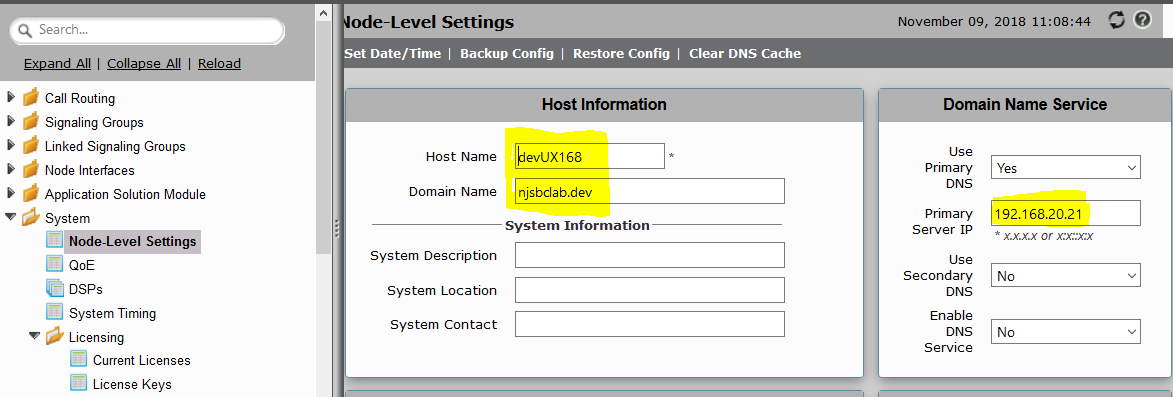 Image Modified Image Modified
|
|
Verifying Certificates on the SBC
- Login to the SBC WebUI and navigate to Security > SBC Certificates.
- Verify that the Trusted CA Certificate and Sonus Certificates are installed:
| Panel |
|---|
|
| Caption |
|---|
|
 Image Modified Image Modified |
|
| Info |
|---|
The following section describes SBC's analog FXS endpoints with Skype for Business in this setup: | Panel |
|---|
| | Caption |
|---|
| 0 | Figure |
|---|
| 1 | Network Diagram: SBC Analog FXS Endpoints With Skype for Business |
|---|
| 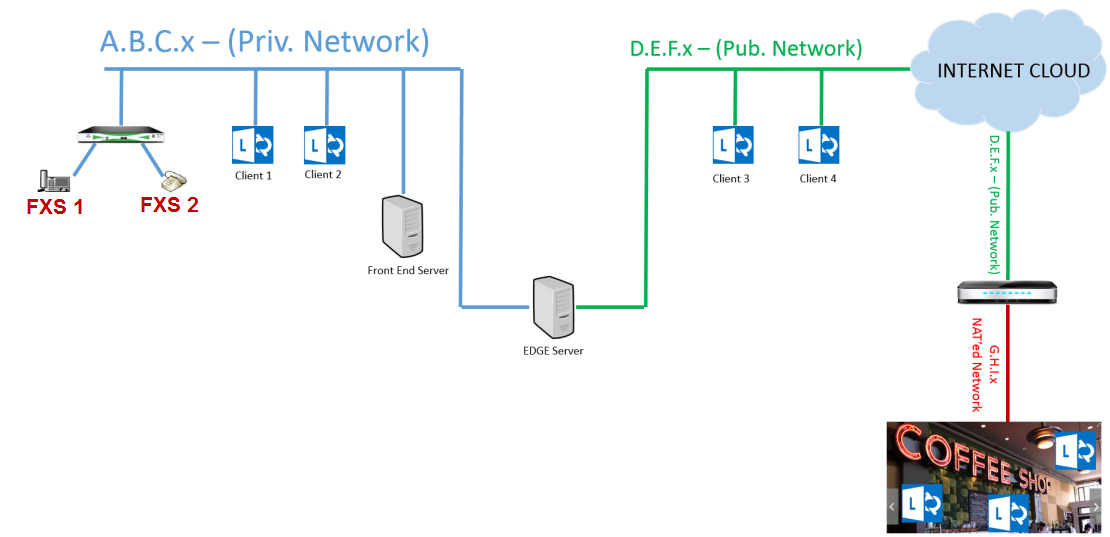 Image Modified Image Modified
|
|
|
Determining Configuration Based on Inter-Op Mode
...
- Login to the SBC WebUI and navigate to SIP > Contact Registrant Table.
- Create a new table.
- Create Contact Registrant Table entries as shown below. Make sure that highlighted values are correspondingly entered with the SIP and tel: URI values in SFB database.
| Panel |
|---|
|
| Caption |
|---|
| 0 | Figure |
|---|
| 1 | Create Contact Registrant Table entries |
|---|
|  Image Modified Image Modified
|
|
| Note |
|---|
The user name, number, and URI association in the CRT must match the corresponding entries in the SfB Control Panel: | Panel |
|---|
| | Caption |
|---|
| 0 | Figure |
|---|
| 1 | SfB Control Panel |
|---|
| 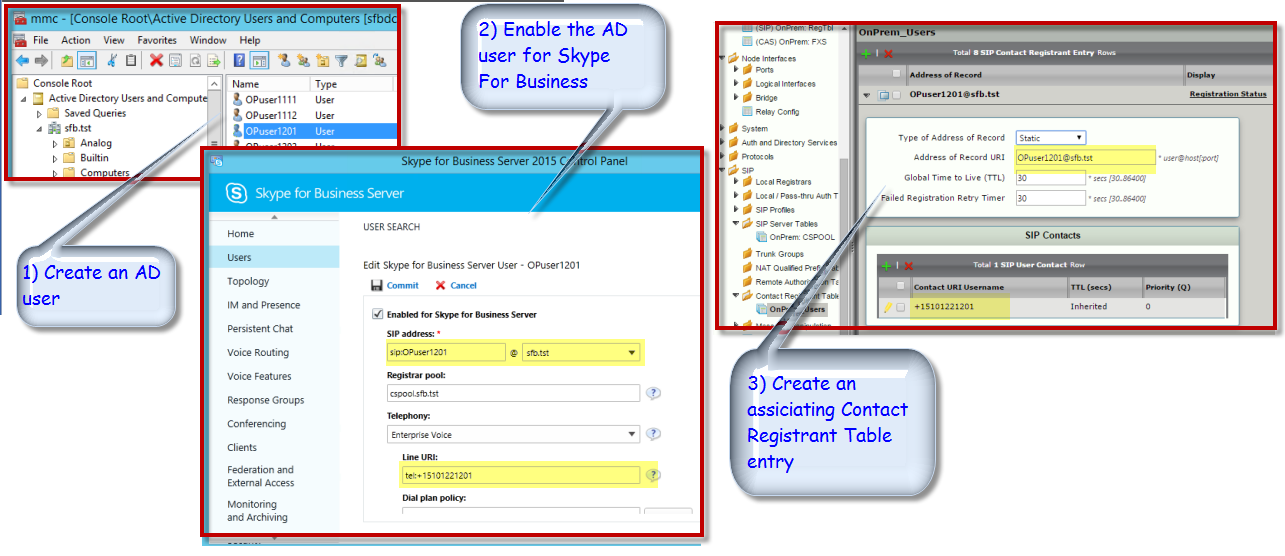 Image Modified Image Modified
|
|
|
Creating a CAS FXS Profile
- Login to the SBC WebUI and navigate to CAS >CAS Signaling Profiles.
- Create an FXS profile as shown below:
| Captionpanel |
|---|
|
| 0 | | | Figure | | 1 | Creating a CAS FXS Profile |
|---|
| 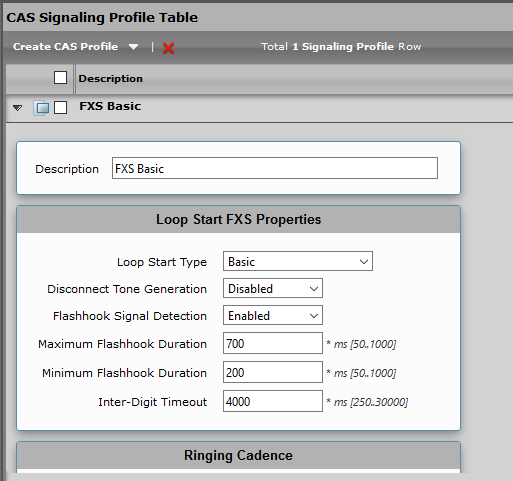 Image Modified Image Modified
|
|
|---|
Creating an FXS to SfB Transformation Table
...
| Note |
|---|
This transformation table entry will translate the 11-digit 15101221201 called number from FXS endpoints to +15101221201. |
| Panel |
|---|
|
| Caption |
|---|
| 0 | Figure |
|---|
| 1 | Transformation Table |
|---|
|  Image Modified Image Modified
|
|
Creating an FXS to SfB Call Routing Table
...
| Note |
|---|
This Route Table entry will use the above transformation table entry and route this call to SIP Signaling group. |
| Panel |
|---|
|
| Caption |
|---|
| 0 | Figure |
|---|
| 1 | Call Routing Table |
|---|
| 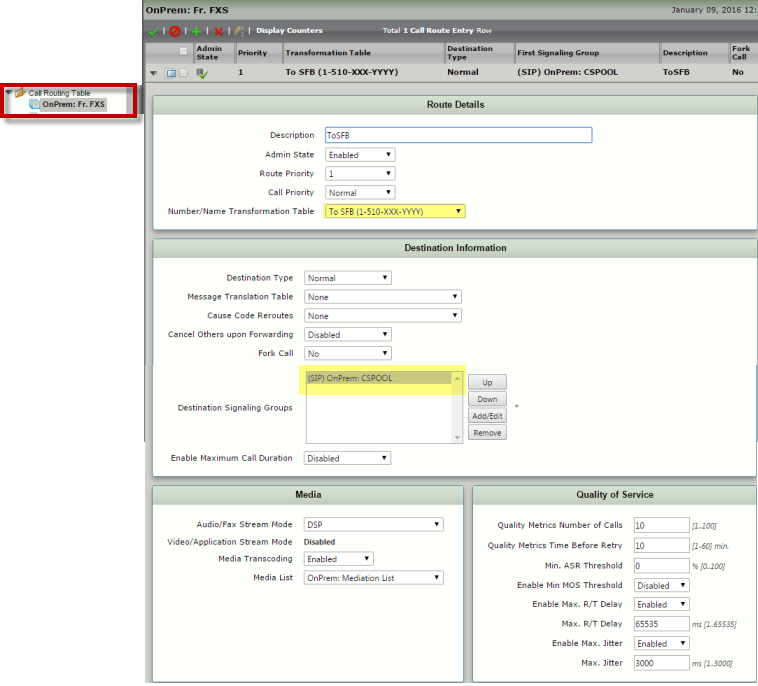 Image Modified Image Modified
|
|
Creating a CAS FXS Signaling Group
...
| Note |
|---|
In this Signaling Group, 4-digit numbers are defined in association of the OnPrem user's tel: URI numbers. For simplicity, 4-digit extensions of the tel: URI is used, such as 1201 for tel:+15101221201. |
| Panel |
|---|
|
| Caption |
|---|
| 0 | Figure |
|---|
| 1 | Creating a CAS FSX Signaling Group |
|---|
| 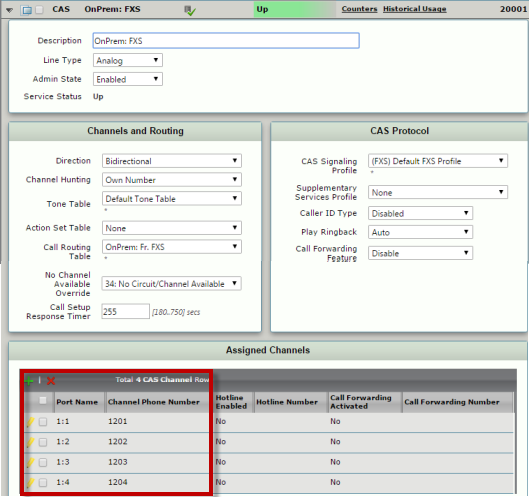 Image Modified Image Modified
|
|
Creating an SBC to FXS Transformation Table
...
| Note |
|---|
This transformation table entry will translate tel: URI number +15101221201 called number from SBC to a 4-digit extension number that was used in CAS signaling group numbers such as 120. |
| Panel |
|---|
|
| Caption |
|---|
| 0 | Figure |
|---|
| 1 | Creating an SBC to FXS Transformation Table |
|---|
|  Image Modified Image Modified |
|
Creating an SfB to FXS Call Routing Table
...
| Note |
|---|
This Route Table entry will use the preceding transformation table entry and route this call to FXS Signaling group. |
| Panel |
|---|
|
| Caption |
|---|
| 0 | Figure |
|---|
| 1 | Creating an SFB to FXS Call Routing Table |
|---|
| 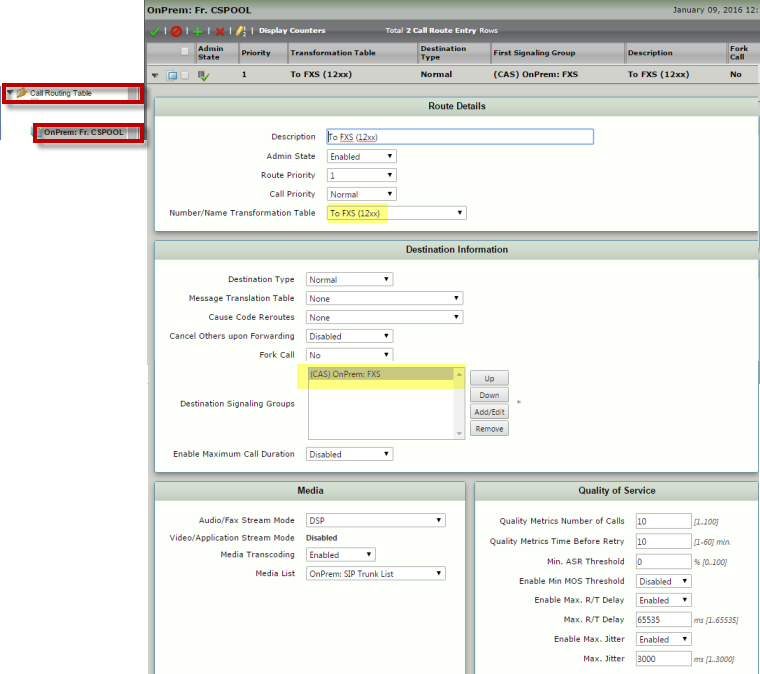 Image Modified Image Modified
|
|
Creating a Mediation Crypto Profile
- Login to the SBC WebUI and navigate to Media > Media Crypto Profiles.
- Create a Mediation Crypto profile as shown below.
| Panel |
|---|
|
| Caption |
|---|
| 0 | Figure |
|---|
| 1 | Creating a Media Crypto Profile |
|---|
| 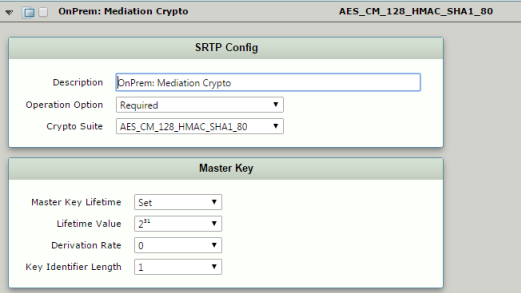 Image Modified Image Modified
|
|
Creating a Mediation List
- Login to the SBC WebUI and navigate to Media > Media List.
- Create a Mediation List as shown below. Make sure to apply the Crypto Profile because it is needed by SFB calls.
| Panel |
|---|
|
| Caption |
|---|
| 0 | Figure |
|---|
| 1 | Creating a Mediation List |
|---|
| 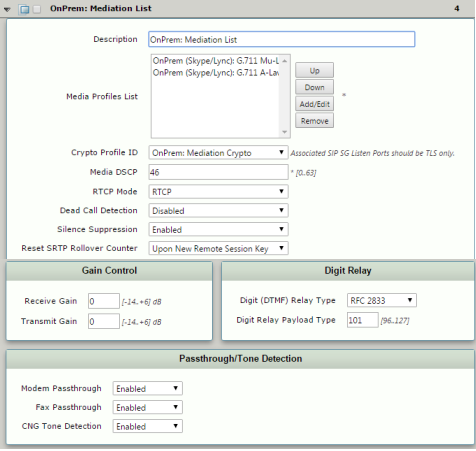 Image Modified Image Modified
|
|
Creating a SIP Signaling Profile
- Login to the SBC WebUI and navigate to SIP > SIP Profiles.
- Create a SIP Profile as shown below.
| Panel |
|---|
|
| Caption |
|---|
| 0 | Figure |
|---|
| 1 | Creating a SIP Signaling Profile |
|---|
| 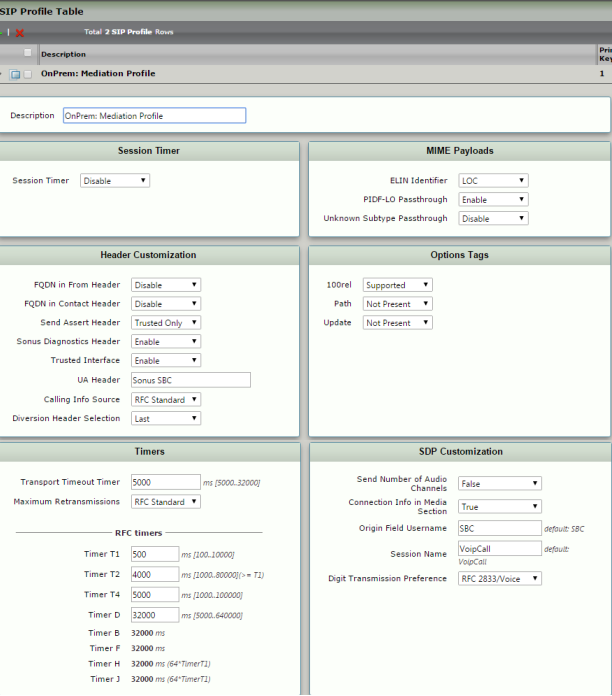 Image Modified Image Modified
|
|
Creating a SIP Server Table
...
| Note |
|---|
The earlier Contact Registrant Table is applied to the Server Table. This will allow CRT entries to register with Skype For Business. |
| Panel |
|---|
|
| Caption |
|---|
| 0 | Figure |
|---|
| 1 | Creating a SIP Server Table |
|---|
| 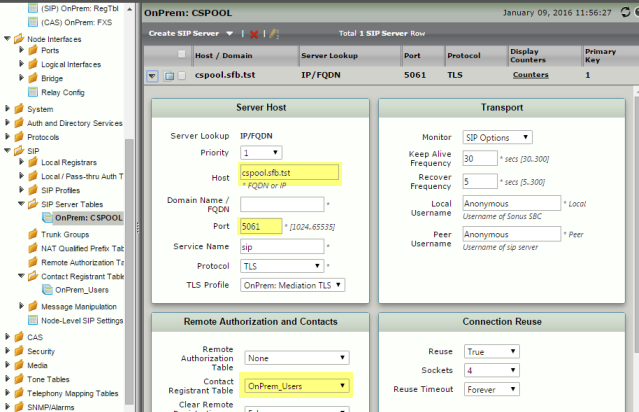 Image Modified Image Modified
|
|
Creating a SIP Signaling Group
| Note |
|---|
Apply the previously created SIP Profile, Media List, Call Routing Table, and SIP Server Table entries to this Signaling Group. In addition, set the inter-op mode as Office 365, and ensure that the Office 365 FQDN matches the dns suffix used in SfB user's profile. |
| Panel |
|---|
|
| Caption |
|---|
| 0 | Figure |
|---|
| 1 | Creating a SIP Signaling Group |
|---|
| 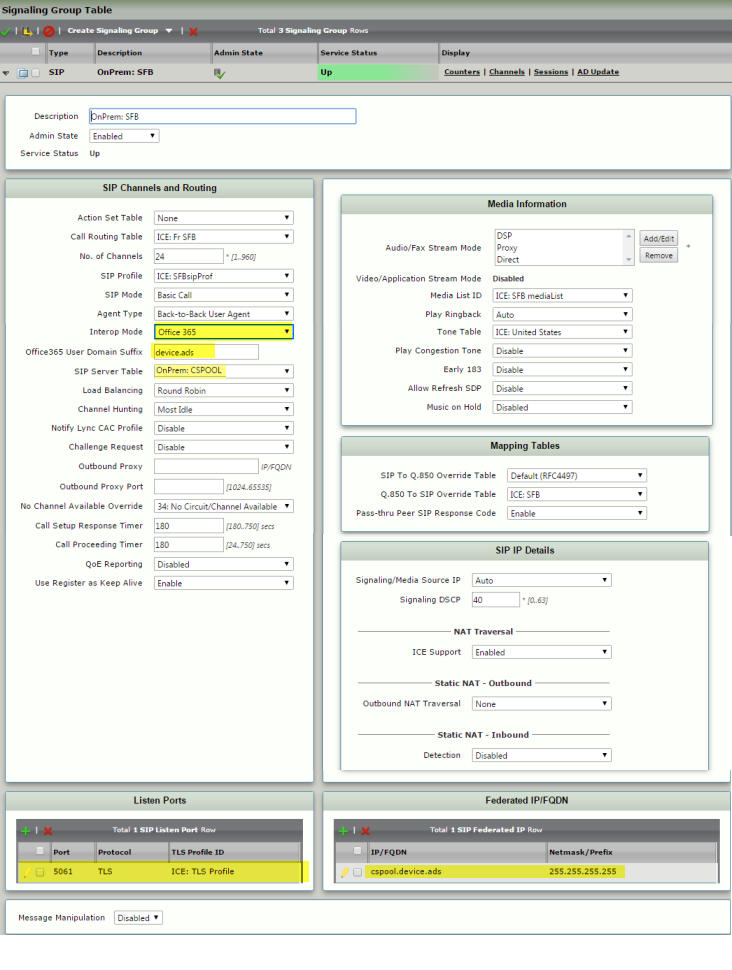 Image Modified Image Modified
|
|
o365 with AD
...
- Login to the SBC WebUI and navigate to CAS >CAS Signaling Profiles.
- Create an FXS profile as shown below.
| Panel |
|---|
|
| Caption |
|---|
| 0 | Figure |
|---|
| 1 | Creating a CAS FXS Profile |
|---|
| 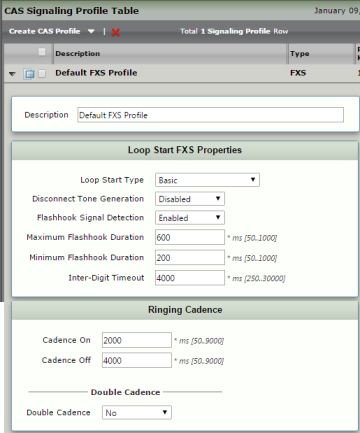 Image Modified Image Modified
|
|
Creating an FXS to SfB Transformation Table
...
| Note |
|---|
This transformation table entry will translate 11 digit 15101221201 called number from FXS endpoints to +15101221201. |
| Panel |
|---|
|
| Caption |
|---|
| 0 | Figure |
|---|
| 1 | Creating an FXS to SFB Transformation Table |
|---|
|  Image Modified Image Modified |
|
Creating an FXS to SfB Call Routing Table
...
| Note |
|---|
This Route Table entry will use the preceding transformation table entry and route this call to SIP Signaling group. |
| Panel |
|---|
|
| Caption |
|---|
| 0 | Figure |
|---|
| 1 | Creating an FXS to SFB Call Routing Table |
|---|
| 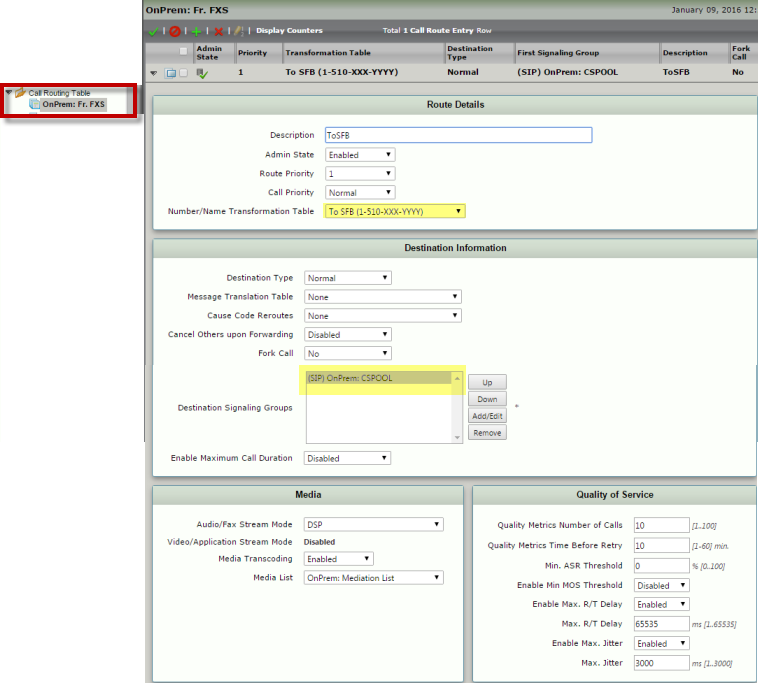 Image Modified Image Modified
|
|
Creating an FXS Signaling Group
...
| Note |
|---|
In this Signaling Group, 4 digit numbers are defined in association with the OnPrem user's tel: URI numbers. For the simplicity, 4 digit extensions of the tel: URI is used such as, 1201 for tel:+15101221201. |
| Panel |
|---|
|
| Caption |
|---|
| 0 | Figure |
|---|
| 1 | Creating an FXS Signaling Group |
|---|
| 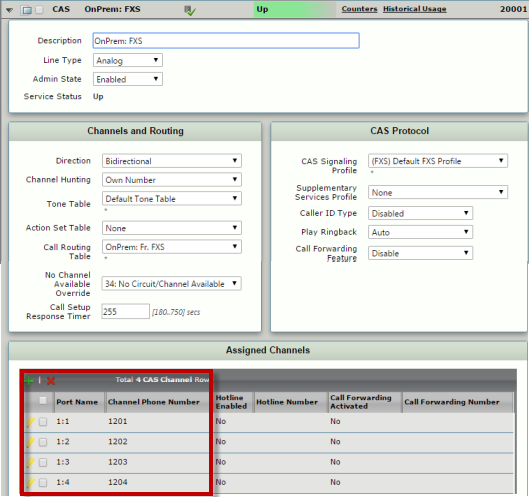 Image Modified Image Modified
|
|
Creating an SBC to FXS Transformation Table
...
| Note |
|---|
This transformation table entry will translate tel: URI number +15101221201 called number from SBC to 4 digit extension number that was used in CAS signaling group numbers such as 1201. |
| Panel |
|---|
|
| Caption |
|---|
| 0 | Figure |
|---|
| 1 | Creating an SBC to FXS Transformation Table |
|---|
|  Image Modified Image Modified
|
|
Creating an SfB to FXS Call Routing Table
...
| Note |
|---|
This Routing Table entry will use the preceding transformation table entry and route this call to FXS Signaling group. |
| Panel |
|---|
|
| Caption |
|---|
| 0 | Figure |
|---|
| 1 | Creating an SFB to FXS Call Routing Table |
|---|
|  Image Modified Image Modified
|
|
Creating a Mediation Crypto Profile
- Login to the SBC WebUI and navigate to Media > Media Crypto Profiles.
- Create a Mediation Crypto Profile as shown below:
| Panel |
|---|
|
| Caption |
|---|
| 0 | Figure |
|---|
| 1 | OnPrem: Mediation Crypto |
|---|
| 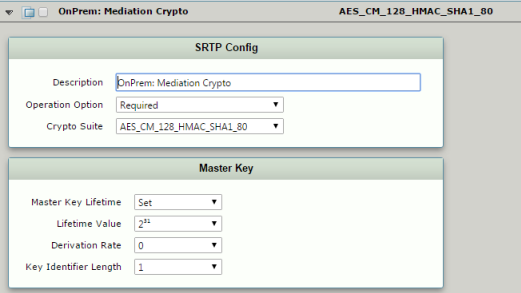 Image Modified Image Modified
|
|
Creating a Mediation List
- Login to the SBC WebUI and navigate to Media > Media List.
- Create a Mediation List as shown below. Make sure to apply the Crypto Profile because it is needed by SfB calls.
| Panel |
|---|
|
| Caption |
|---|
| 0 | Figure |
|---|
| 1 | Creating a Mediation List |
|---|
| 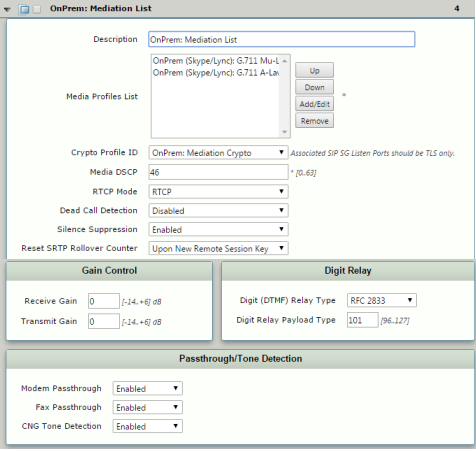 Image Modified Image Modified
|
|
Creating a SIP Signaling Profile
- Login to the SBC WebUI and navigate to SIP > SIP Profiles.
- Create a SIP Profile as shown below.
| Panel |
|---|
|
| Caption |
|---|
| 0 | Figure |
|---|
| 1 | Creating a SIP Signaling Profile |
|---|
| 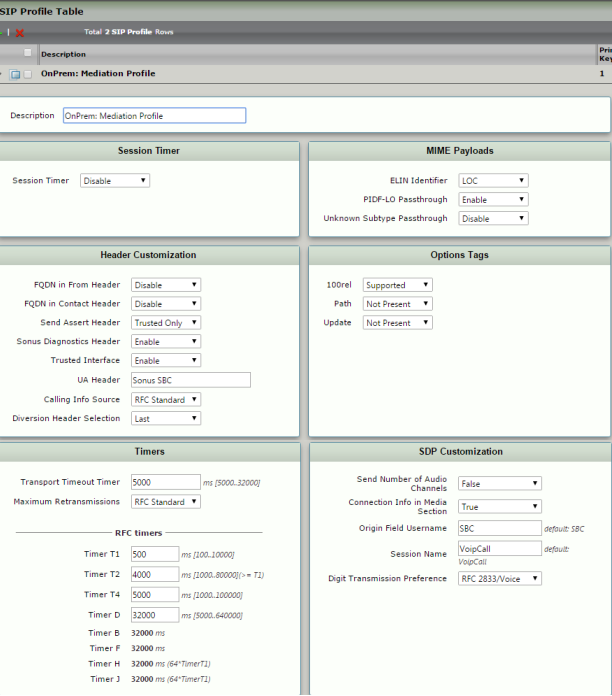 Image Modified Image Modified
|
|
Creating a SIP Server Table
...
| Note |
|---|
The existing Contact Registrant Table is applied to the Server Table. This will allow CRT entries to register with Skype for Business. |
| Panel |
|---|
|
| Caption |
|---|
| 0 | Figure |
|---|
| 1 | Creating a SIP Server Table |
|---|
| 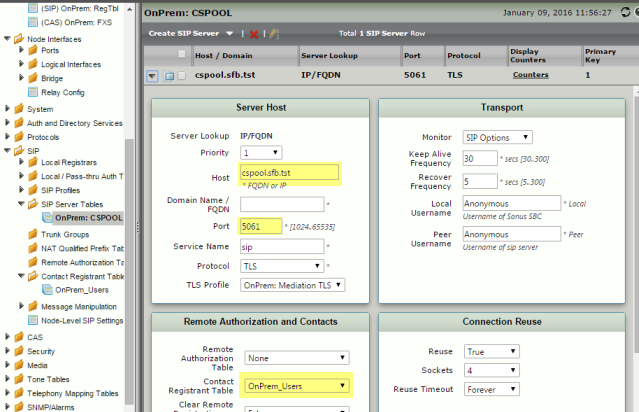 Image Modified Image Modified
|
|
Domain Controller and Active Directory
...
- Domain Controller with relevant search scope for the OnPrem Users
- Active Directory Configuration with relevant user attributes
| Captionpanel |
|---|
|
| 0 | | | Figure | | 1 | Domain Controller and Active Directory |
|---|
| 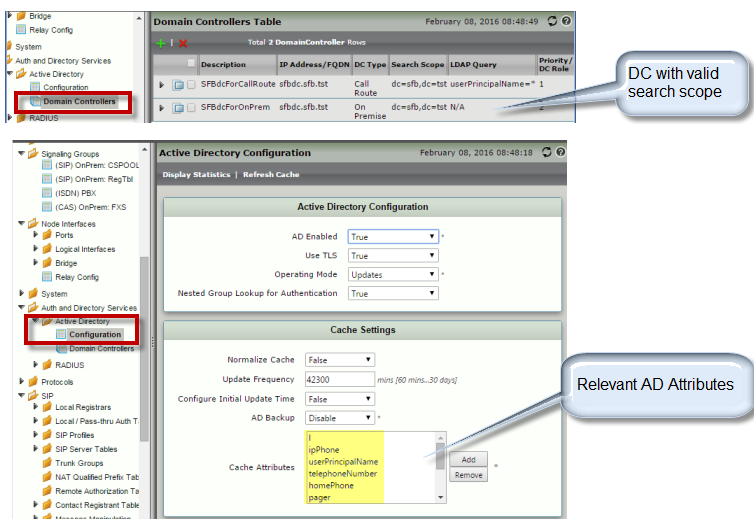 Image Modified Image Modified
|
|
|---|
In this case, we use the
pager attribute to query and to register the user with it. Make sure to have the AD user created with the
pager attribute as shown below:
| Panel |
|---|
|
| Caption |
|---|
| 0 | Figure |
|---|
| 1 | Pager Attribute set |
|---|
| 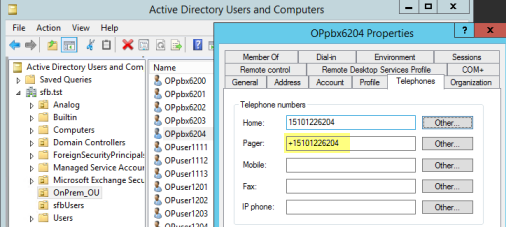 Image Modified Image Modified
|
|
Creating a SIP Signaling Group
| Note |
|---|
Note that previously created SIP Profile, Media List, Call Routing Table, and the SIP Server Table entries are applied to this Signaling Group. In addition, the inter-op mode is set as Office 365 w/AD PBX, AD Attribute as pager, and the Office 365 FQDN is matching with the dns suffix that is used in SFB user's profile. |
| Panel |
|---|
|
| Caption |
|---|
| 0 | Figure |
|---|
| 1 | Creating a SIP Signaling Group |
|---|
| 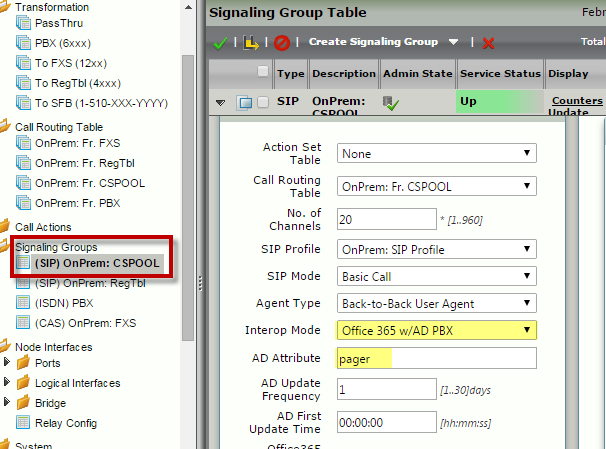 Image Modified Image Modified
|
|
o365 with CRT and AD
| Anchor |
|---|
| o365 with CRT and AD |
|---|
| o365 with CRT and AD |
|---|
|
...
- Login to the SBC WebUI and navigate to SIP > Contact Registrant Table.
- Create a new table.
- Create the relevant Contact Registrant Table Entries as shown below; make sure that highlighted values are accordingly entered with the SIP and tel: URI values in SFB database.
| Panel |
|---|
|
| Caption |
|---|
| 0 | Figure |
|---|
| 1 | Creating Contact Registrant Table Entries |
|---|
|  Image Modified Image Modified
|
|
| Note |
|---|
The sequence and user name, number, and URI association should be similar to the following: | Panel |
|---|
| | Caption |
|---|
| 0 | Figure |
|---|
| 1 | Contact Registrant Table - Result |
|---|
| 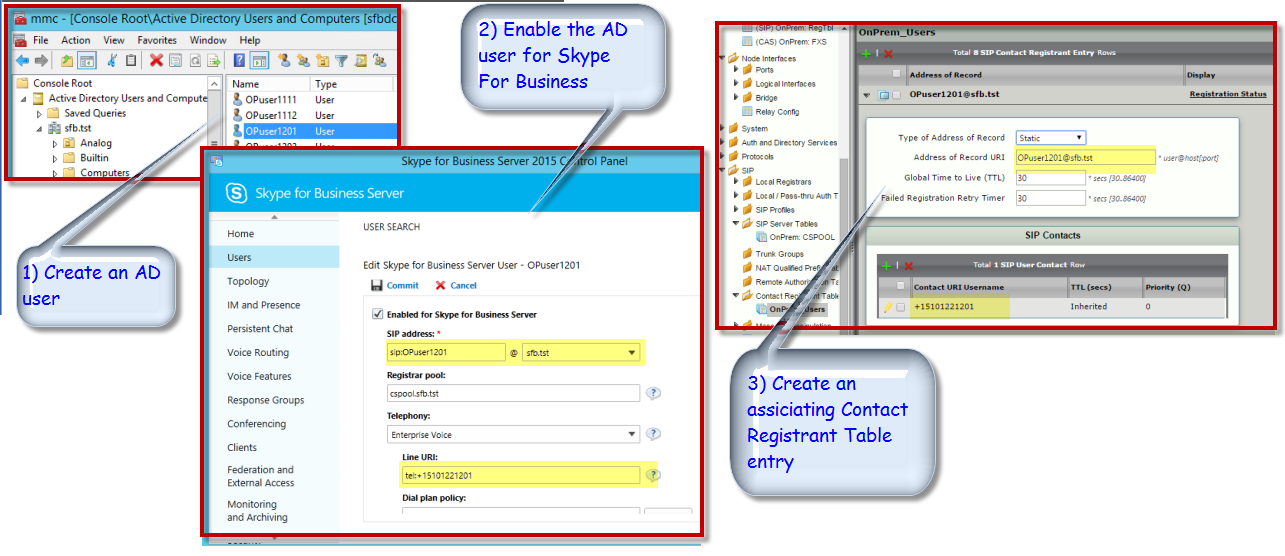 Image Modified Image Modified
|
|
|
Creating a CAS FXS Profile
- Login to the SBC WebUI and navigate to CAS >CAS Signaling Profiles.
- Create an FXS profile as shown below.
| Panel |
|---|
|
| Caption |
|---|
| 0 | Figure |
|---|
| 1 | Creating a CAS FXS Profile |
|---|
| 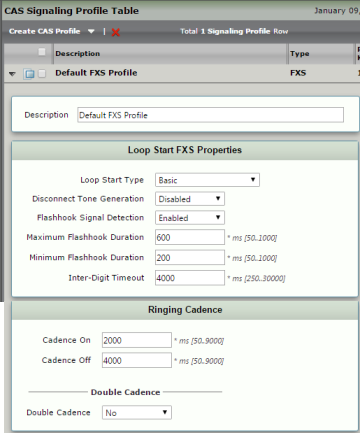 Image Modified Image Modified
|
|
Creating an FXS to SfB Transformation Table
...
| Note |
|---|
This transformation table entry will translate 11 digit 15101221201 called number from FXS endpoints to +15101221201. |
...
|
| Caption |
|---|
| 0 | Figure |
|---|
| 1 | Creating an FXS to SFB Transformation Table |
|---|
|  Image Modified Image Modified |
|
Creating an FXS to SfB Call Routing Table
...
| Note |
|---|
This Route Table entry will use the preceding transformation table entry and route this call to SIP Signaling group. |
| Panel |
|---|
|
| Caption |
|---|
| 0 | Figure |
|---|
| 1 | Creating an FXS to SFB Call Routing Table |
|---|
| 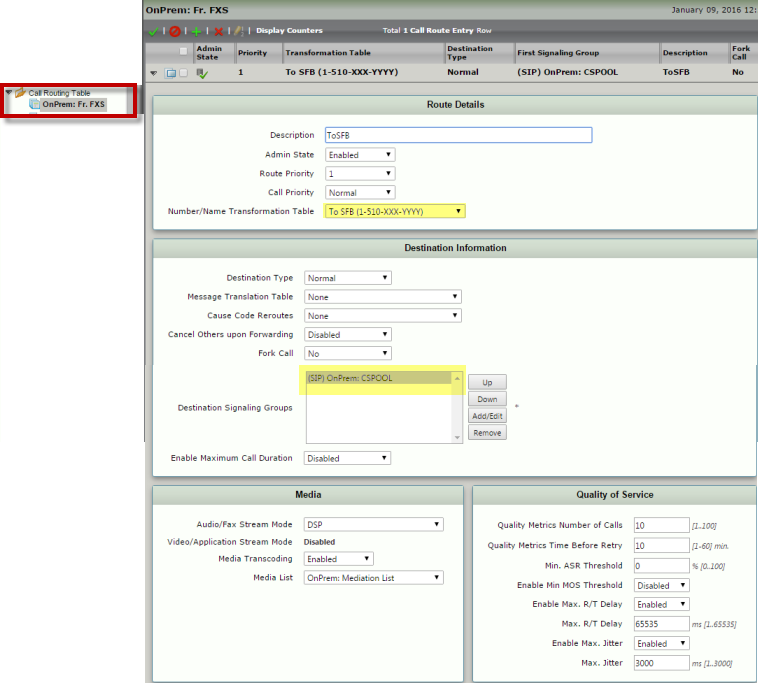 Image Modified Image Modified
|
|
...
Creating an FXS Signaling Group
...
| Note |
|---|
In this Signaling Group, 4 digit numbers are defined in association with the OnPrem user's tel: URI numbers. For the simplicity, 4 digit extensions of the tel: URI is used such as, 1201 for tel:+15101221201.15101221201. |
| Panel |
|---|
|
| Caption |
|---|
| 0 | Figure |
|---|
| 1 | Creating an FXS Signaling Group |
|---|
| 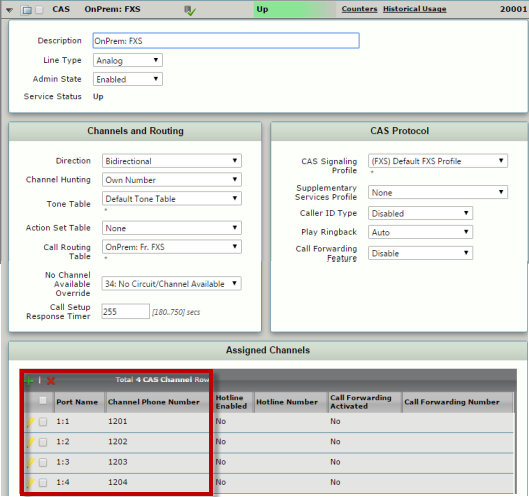 Image Modified Image Modified
|
|
Creating an SBC to FXS Transformation Table
...
| Note |
|---|
This transformation table entry will translate tel: URI number +15101221201 called number from SBC to 4 digit extension number that was used in CAS signaling group numbers such as 1201. |
| Panel |
|---|
|
| Caption |
|---|
| 0 | Figure |
|---|
| 1 | Creating an SBC to FXS Transformation Table |
|---|
|  Image Modified Image Modified
|
|
Creating an SfB to FXS Call Routing Table
...
| Note |
|---|
This Routing Table entry will use the preceding transformation table entry and route this call to FXS Signaling group. |
| Panel |
|---|
|
| Caption |
|---|
| 0 | Figure |
|---|
| 1 | Creating an SFB to FXS Call Routing Table |
|---|
| 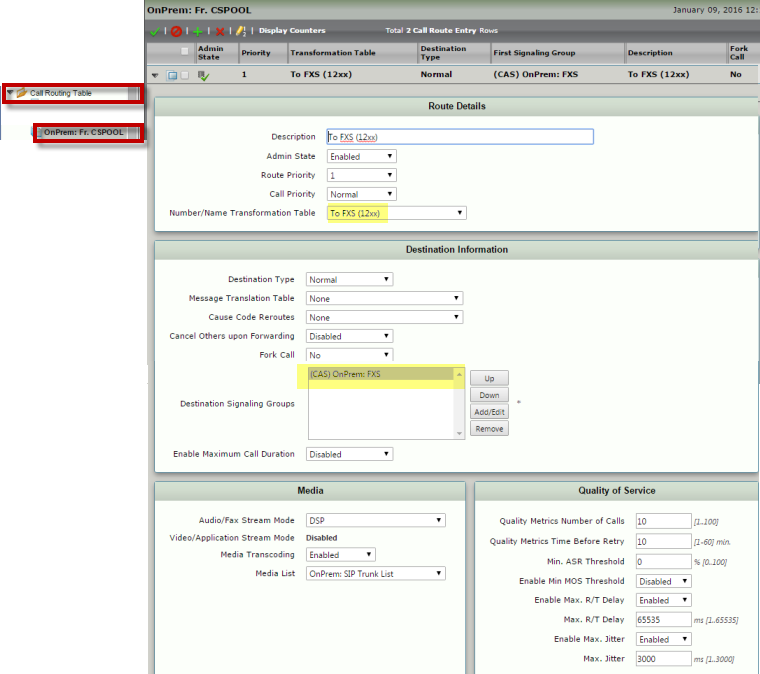 Image Modified Image Modified
|
|
Creating a Mediation Crypto Profile
- Login to the SBC WebUI and navigate to Media > Media Crypto Profiles.
- Create a Mediation Crypto Profile as shown below:
| Panel |
|---|
|
| Caption |
|---|
| 0 | Figure |
|---|
| 1 | OnPrem: Mediation Crypto |
|---|
| 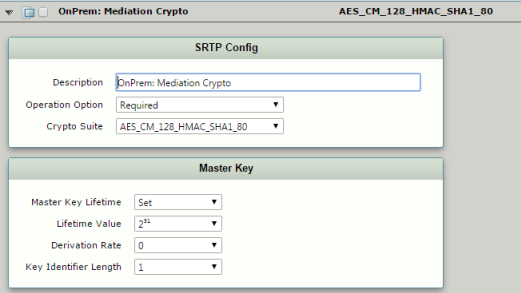 Image Modified Image Modified
|
|
Creating a Mediation List
- Login to the SBC WebUI and navigate to Media > Media List.
- Create a Mediation List as shown below. Make sure to apply the Crypto Profile because it is needed by SfB calls.
| Panel |
|---|
|
| Caption |
|---|
| 0 | Figure |
|---|
| 1 | Creating a Mediation List |
|---|
| 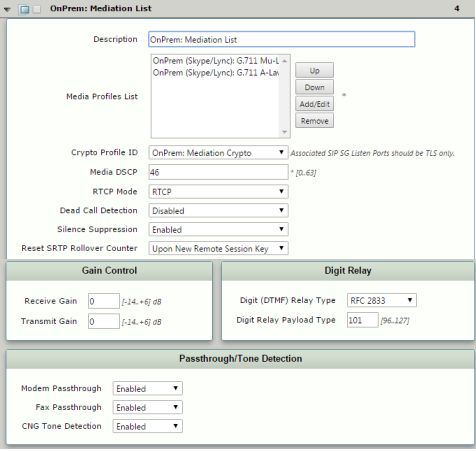 Image Modified Image Modified
|
|
Creating a SIP Signaling Profile
- Login to the SBC WebUI and navigate to SIP > SIP Profiles.
- Create a SIP Profile as shown below.
| Panel |
|---|
|
| Caption |
|---|
| 0 | Figure |
|---|
| 1 | Creating a SIP Signaling Profile |
|---|
| 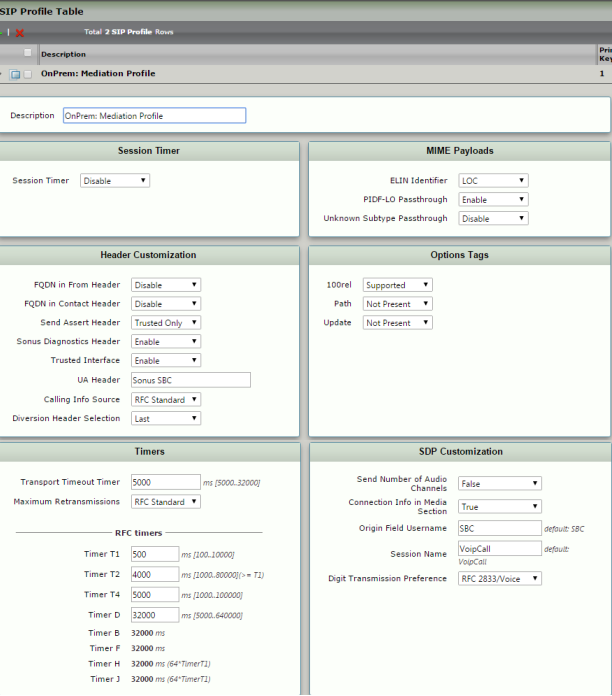 Image Modified Image Modified
|
|
Creating a SIP Server Table
...
| Note |
|---|
The existing Contact Registrant Table is applied to the Server Table. This will allow CRT entries to register with Skype for Business. |
| Panel |
|---|
|
| Caption |
|---|
| 0 | Figure |
|---|
| 1 | Creating a SIP Server Table |
|---|
| 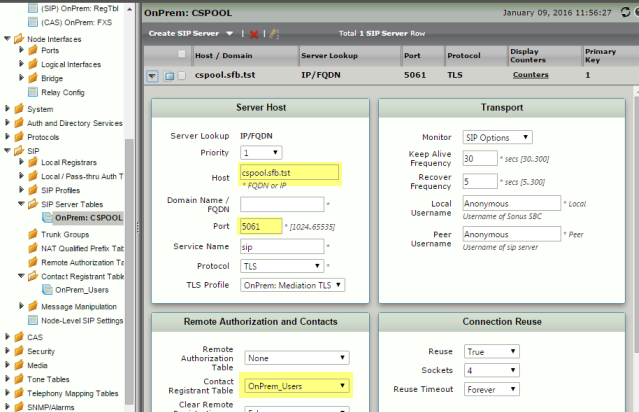 Image Modified Image Modified
|
|
Domain Controller and AD
...
- Domain Controller with relevant search scope for the OnPrem users.
- Active Directory Configuration with relevant user attributes.
| Panel |
|---|
|
| Caption |
|---|
| 0 | Figure |
|---|
| 1 | Search Scope and Relevant AD Attributes |
|---|
| 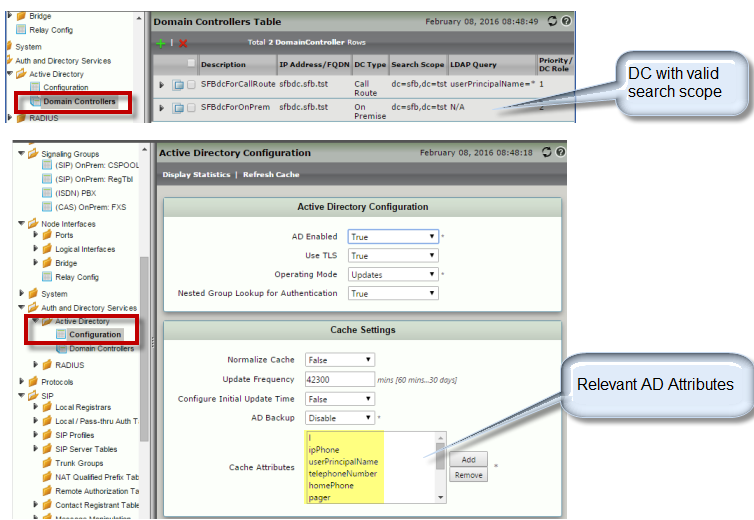 Image Modified Image Modified
|
|
In this case, the pager attribute is used to query and register the user. Make sure to have the AD user created with the pager attribute as shown below:| Panel |
|---|
|
| Caption |
|---|
| 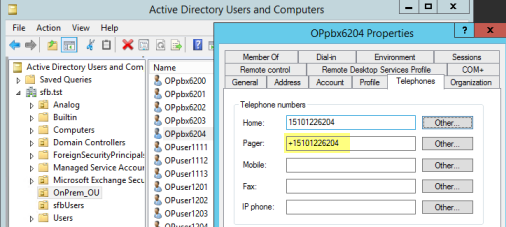 Image Modified Image Modified |
|
Configuring a SIP Signaling Group
...
Signaling Group with interop mode as Office 365 w/AD PBX and AD attribute as pager (for this exercise).
| Panel |
|---|
|
| Caption |
|---|
| 0 | Figure |
|---|
| 1 | Creating a SIP Signaling Group |
|---|
| 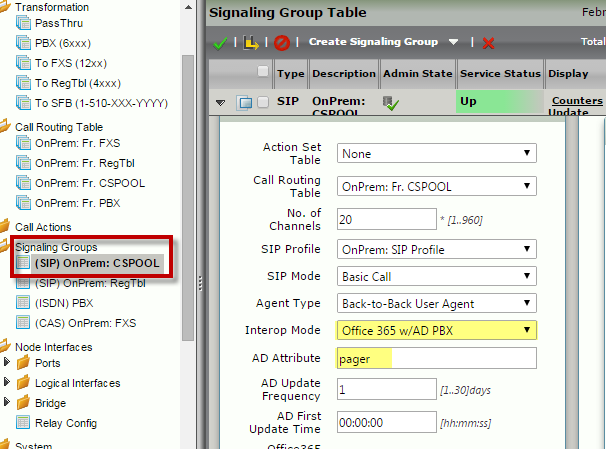 Image Modified Image Modified
|
|
Enabling ICE Support for MS SfB EDGE Server Integration
...
- Remote Authorization Table Entry with the Realm of SfB's domain suffix, a valid domain user, and its credentials as shown below.
- SIP Server Table with the FQDN of the EDGE Server, Port 5062, protocol as TLS, the TLS profile that is used for SfB Front End Pool integration, and the Remote Authorization Table entry that is created in the previous step as shown below.
- Node Level SIP Settings that is configured with the EDGE SIP Server table (from the previous step) as EDGE Server Destination settings as shown below.
- Front End Pool SIP Signaling Group configured with ICE Support settings as enabled as shown below:
| Panel |
|---|
|
| Caption |
|---|
| 0 | Figure |
|---|
| 1 | Enabling ICE Support |
|---|
| 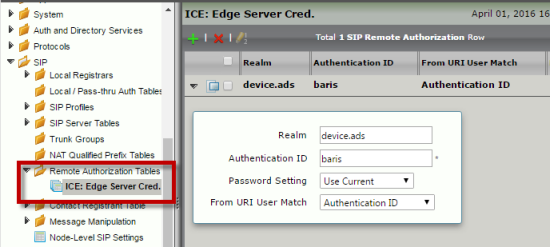 Image Modified Image Modified 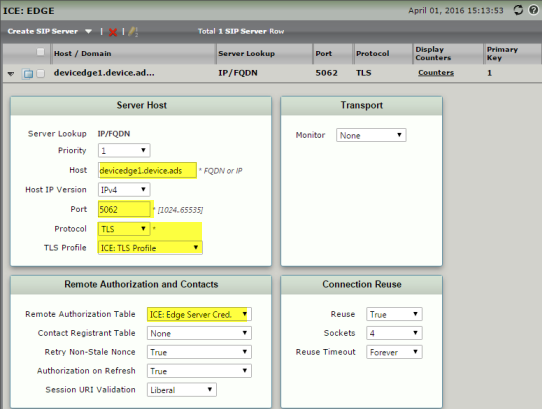 Image Modified Image Modified
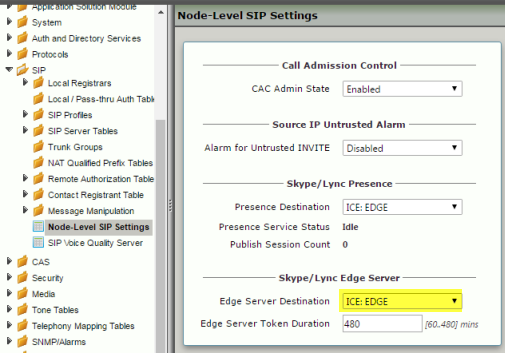 Image Modified Image Modified 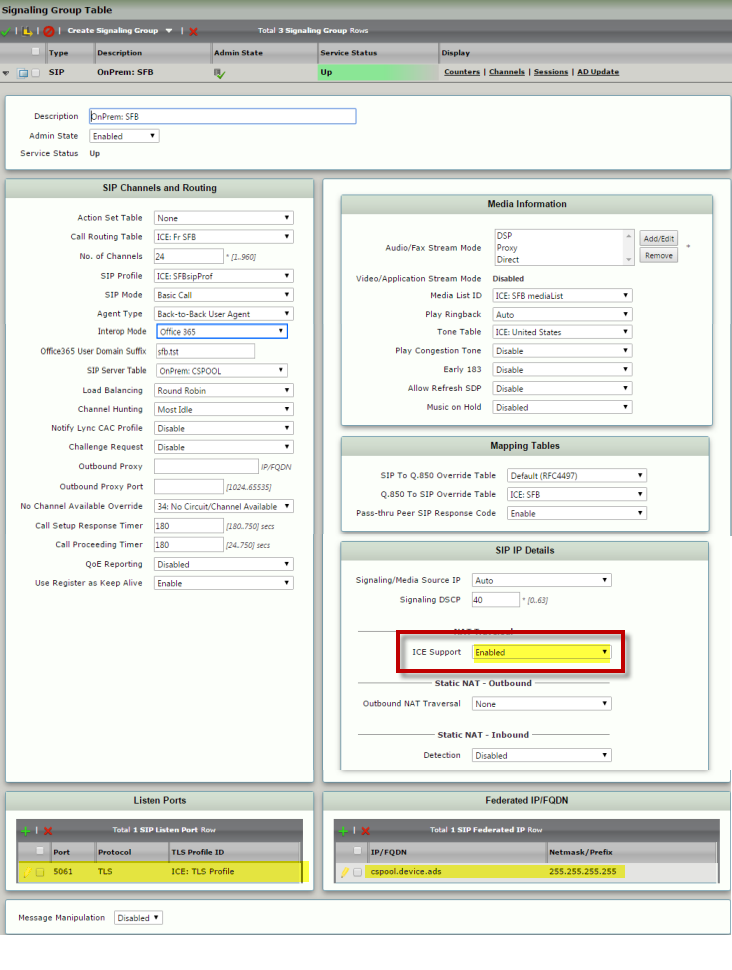 Image Modified Image Modified
|
|


















































